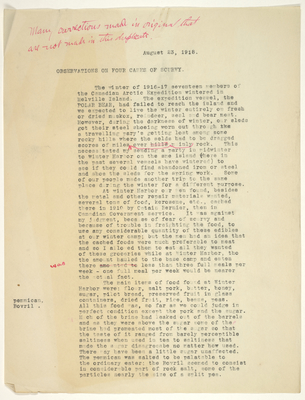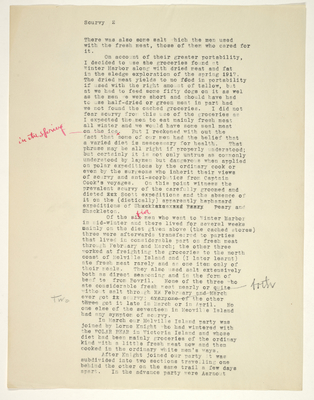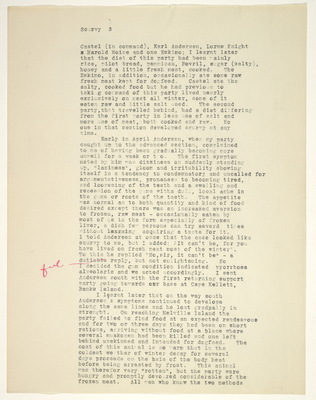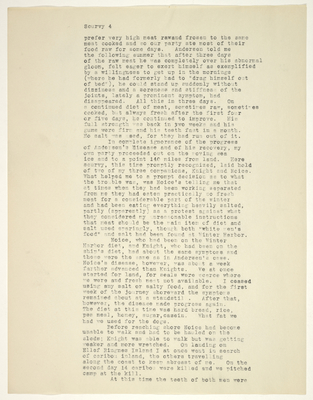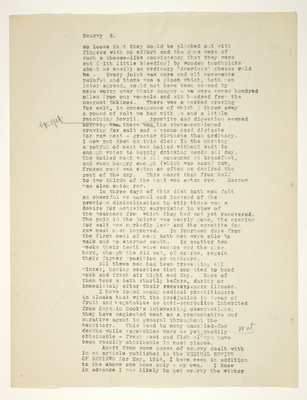Pages
stefansson-wrangel-09-40-004-001
Many corrections made in orginal that are not made in this duplicate.
August 23, 1918. OBSERVATIONS ON FOUR CAFES OF SCURvY.
The winter of 1916-17 seventeen members the Canadian Arctic Expedition wintered in Melville Island. The expedition vessel, the POLAP BEAR, had failed to reach the island and we expected to live the winter entirely on fresh or dried muskox, reindeer, seal and bear meat. However, during the darkness of winter, or sleds got their steel shoeing worn out through the a travelling pary's getting lost among some rocky hills where the selds had to he dragged scores of miles mainly over hills rock. This necessitated my sending a party in midwinter to Winter Harbor on the sme island (where in the past several vessels have wintered) to see if they could find abandoned iron or steel and shoe the sleds for the spring work. Some of our people made another trip to the same place during the winter for a different purpose.
At winter Harbor or men found, besides the metal and other repair materials wanted, several tons of food, kerosene, etc., cached there in 1910 by Cotain Bernier, then in Canadian Government service. It was against my jugdement, because of fear of scurvy and because of trouble in freighting the food, to use any considerable quantity of these edibles at our winter camp; but the men had an idea that the cached foods were much preferable to meat and so I allowed them to eat all they wanted of these groceries while at Winter Harbor, tho the amount hauled to the base camp and eaten there amounted to less than three full reals per week - one full meal per week would be nearer the actual fact.
The main items of food found at Winter Harbor were: flour, salt pork, butter, honey, sugar, pilot bread, preserved fruit in glass containers, dried fruit, rice, beans, peas. All this food was, so far as we could judge in perfect condition except the pork and the sugar. Much of the brine had leaked out of the barrels and as they were above the sugar some of the brine had premeated most of the sugar so that the taste of it ranged from barely perceptible saltiness when used in tea to saltiness that made the sugar disagreeabe no matter how used. There may have been a little sugar unaffected. The penmican was salted to be palatable to the ordinary eater: the Bovril seemed to consist in considerable part of rock salt, some of the particles nearly the size of a split pea.
stefansson-wrangel-09-40-004-002
Scurvy 2
There was also some salt which the men used with the fresh meat, those of them who cared for it.
On account of their greater portability, I decided to use the groceries found at Winter Harbor along with dried meat and fat in the sledge exploration of the spring 1917. The dried meat yields to no food in portability if used with the right amount of tallow, but at we had to feed some fifty dogs on it as wel as the men we were short and should have had to use half-dried or green meat in part had we not found the cached groceries. I did not fear scurvy from this use of the groceries as I expected the men to eat mainly fresh meat all winter and we would have some seal meat on the ice in the spring. But I reckoned with out the fact that some of our men had the belief that a varied diet is nescessary for health. That phrase may be all right if properly understood; but certainly it is not only untrue as commonly understood by laymen but dangerous when applied on polar expeditions by the ordinary cook or even by the surgeons who inherit their views of scurvy and anti-acorbutics from Captain Cook’s voyages. On this point witness the prevalent scurvy of the carefully groomed and dieted Six Scott expeditions and the absence of it on the (dietically) apparently haphazard expeditions of ShaekisierexxKd Bsaxy Peary and Shackleton.
Of the six five men who went to Winter Harbor in mid-winter and there lived for several weeks mainly on the diet given above (the cached stores) three were afterwards transferred to parties that lived in considerable part on fresh meat through February and March; the other three worked at freighting the groceries to the north coast of Melville Island and (I later learnt) ate fresh meat rarely and as one item only of their meals. They also used salt extensively both as direct seasoning and in the form of beef te from Bovril. None of the three who ate considerable fresh meat nearly or quite without salt through MM February and March ever got it scurvy; everyone of the other three two got it late in March or in April. No one else of the seventeen in Meoville Island had any symptom of scurvy.
In March our Melville Island party was joined by Lorne Knight who had wintered with the POLAP BEAR in Victoria Island and whose diet had been mainly groceries of the ordinay kind with a little fresh meat now and then cooked in the ordinary white men’s ways.
After Knight joined our party it was subdivided into two sections travelling one behind the other on the same trail a few days apart. In the advance party were Aarnout
stefansson-wrangel-09-40-004-003
Scurvy 3
Castel (in command), Karl Andersen, Lorne Knight a Harold Noice and one Eskimo; I learnt later that the diet of this party had been mainly rice, pilot bread, pemrican, Bovril, sugar (salty), honey and a little fresh meat, cooked. The Eskimo, in addition, occasionally ate some raw fresh meat kept for dogfeed. Castel ate the salty, cooked food but he had previous to taking command of this party lived nearly exclusively on meat all winter, some of it eaten raw and little salt used. The second party, that travelled behind, had a diet differing from the first party in less use of salt and more use of meat, both cooked and raw. No one in that section developed scurvy at any time.
Early in April Andersen, when my party caught up to the advanced section, complained to me of having been gradually becoming more unwell for a week or two. The first symptom noted by him was dizziness on suddenly standing up, ''laziness", gloom and irritability showing itself in a tendency to condemnatory and uncalled for argmentativeness, proneness to becoming tired, and loosening of the teeth and a swelling and recession of the gums witha dull, local ache in the gums or roots of the teeth. The appetite was normal as to both quantity and kind of food desired except there was an increased aversion to frozen, raw meat - occasionally eaten by most of us in the form especially of frozen liver, a dish few persons can try serveral times without lssxxing acquiring a taste for it.
I told Andersen at once that the case looked like scurvy to me, but I added; It can’t be, for you have lived on fresh meat most of the winter". To this he replied ’'No, sir, it can’t be” - a dutiable reply, but not enlightening. So I decided the gum condition indicated pyorrhoea alveolaris and we acted accordingly. I sent Andersen south with the first returning support party going towards ou bass at Cape Kellett, Banks Island.
I learnt later that on the way south Andersen's symptoms continued to develops along the same lines and he lost gradually in strenght. On reaching Melville Island the party failed to find food at an expected rendesvous and for two or three days they had been on short rations, arriving without food at a place where several muskoxen had been killed and one left behind, unskinned and intended for degfeed. The coat of this animal is so warm that in the coldest we ther of winter decay for several days proceeds on the basis of the body heat before being arrested by frost. This animal was therefor very '‘rotten", but the party were hungry and promptly devoured considerable of the frozen meat. All men who know the two methods
stefansson-wrangel-09-40-004-004
Scurvy 4
prefer very high meat rawand frosen to the same meat cooked and so our party ate most of their food raw for some days. Andersen told me the following summer that after three days of the raw meat he was completely over his abnormal gloom, felt eager to exert himself as exemplified by a willingness to get up in the mornings (where he had formerly had to "drag himself out of bed"), he could stand up suddenly without dizziness and a soreness end stiffness of the joints, lately a prominent symptom, had disappeared. All this in three days. On a continued diet of meat, sometimes raw, sometimes cooked, but always fresh after the first four or five days, he continued to improve. His full strength was back in two weeks and his guns were firm and his teeth fast in a month. No salt was used, for they had run out of it.
In complete ignorance of the progress of Andersen’s disease and of his recovery, my own party proceeded out on the moving sea ice and to a point 140 miles from land. Here scurvy, this time promptly recognised, laid hold of two of my three companions, Knight and Noice. That helped me to a prompt decision as to what the trouble was, was Noice's telling me that at times when they had been working separated from me they had eaten practically no fresh meat for a considerable part of the winter and had been eating everything heavily salted, partly (apparently) as a protest against what they considered my unreasonable instructions that meat should be the main item of diet and salt used sparingly, though both ‘"white men’s food” and salt had been found at Winter Harbor.
Noice, who had been on the Winter Harbor diet, and Knight, who had been on the ship's diet, had about the same symptoms and these were the same as in Andersen's case. Noice’s disease, however, was about a week farther advanced than Knights. We at once started for land, for seals were scarce where we were and fresh meat not available. I ceased using any salt or salty food, and for the first week of the journey shoreward the symptoms remained about at a standstill . After that, however, the disease made progress again. The diet at this time was hard bread, rice, pea meal, honey, sugar, casein. What fat we had we used for the dogs.
Before reaching shore Noice had become unable to walk and had to be hauled on the sleds; Knight was able to walk but was getting weaker and more wretched. On landing on Ellef Ringnes Island I at once went in search of caribou inland, the others travelling along the const to keep abreast of me. On the second day 14 caribo- were killed and we pitched camp at the kil1.
At this time the teeth of both were
stefansson-wrangel-09-40-004-005
Scurvy 5.
so loose that they could be plucked out with fingers with no effort and the gums were of such a cheese-like consistency that they were cut (with little bleeding) by wooden toothpicks about as easily as ordinary ’’American" cheese ould be . Every joint was sore and all movements painful and there was a gloom which, both men later agreed, could not have been caused by mere worry over their danger - we were seven hundred miles from our vessels and six hundred from the nearest Eskimos. There was a marked craving for salt, in consequence of which I threw away a pound of salt we had with us and a little remaining Bovril. Appetite and digestion seemed normal, the except there was the above-mentioned craving for salt and a pronounced distaste for raw meat - greater distaste than ordinary. I now put then on this diet: In the morning a potful of meat was boiled without salt in enough water to supply drinking needs all day . The boiled meat was all consumed at breakfast, and when hungry enough (which was soon) raw, frozen meat was eaten, as often as desired the rest of the day. This meant that from half to two thirds of the meat was eaten raw. Marrow was also eaten raw. In three days of this diet both men felt as cheerful as normal and instead of the previous disinclination to stir there was a desire for activity surprising in view of the weakness from which they had not yet recovered. The pain in the joints was nearly gone, the craving for salt was markedly less and the appetite for raw meat much improved. In fourteen days from the first meal of meat both men were able to walk and we started south. In another two weeks their teeth wore secure and the gums hard, though the did not, of course regain their former position or contours.
All these men had been travelling all winter, having exercise that amounted to hard work and fresh air night and day. None of them took a bath shortly before, during or immediately after their recoveryxxxxx illness.
I have found among medical practitioners in Alaska that with the prejudice in favor of fruit and vegetables as antiscorbutics inherited from Captain Cook's interesting observations, they have neglected meat as a preventative and curative agent in general throughout the territory. This lead to many uncalled-for deaths while vegetables were as yet readily obtainable - fresh meat and fish not always have been readily obtainable in most places.
Apart from some cases of scurvy dealt with in an article published in the MEDICAL REVIEW OF REVIEWS for May, 1918, I have seen in addition to the above one case only - my own. I knew in advance I was likely to get scurvy the winter
